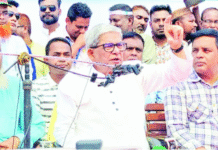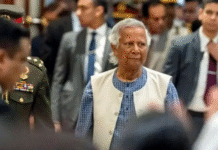Around 11,000 apparel workers of 99 factories in the capital as well as Ashulia, Savar, Gazipur and Narayanganj were fired and 3,500 others implicated in 34 cases as fallout of their movement held in January to press the demand of proportionately wage hike, according to the IndustryAll Bangladesh Council.
IBC leaders said that the sacked workers, mostly union leaders, activists or senior workers, were not getting jobs anywhere as the owners posted their information on websites.
They also said that the repressive cases filed against workers by factory owners might create another unrest in the apparel industry soon.
IBC, a platform of 13 trade union federations, demanded an end to indiscriminate dismissals and arrests and responsible behaviour from the garment factory owners.
Addressing a news conference at National Press Club Tuesday, IBC chairman Md Giasuddin Ahmed demanded withdrawal of all the false and fabricated cases and release of all the detained workers and reinstatement of 11,000 sacked workers.
IBC former general secretary Kutubuddin Ahmed urged the government to form a tripartite committee comprising of representatives of the owners, the government and the labour leaders to investigate into causes of the unrest.
IBC vice president and also president of the National Garment Workers Federation Amirul Haque Amin said that the BGMEA has prepared a biometric database of 35 lakhs garment workers to use against the workers to infringe upon their rights.
The leaders sought the government intervention to stop workers’ repression.
They said that the government and the BGMEA would by not meeting their demands would compel them to take up the issues with international forums.
On January 28, Industrial police said a total of 4,899 workers of garment factories were sacked as a fallout of their movement for pay hike.
Director general of industrial police Abdus Salam said that they did not update the list.
IBC secretary general Salahuddin Shapon said that the number of terminated workers would increase as their sacking continued.
He also said that many workers were harassed by police even at their homes.
Bangladesh Garment Manufacturers and Exporters Association president Md Siddiqur Rahman said that the factory owners had the legal right to sack workers.
He said that no innocent worker was fired or sued.
About the database, he said that they were preparing the database by the suggestion of International Labour Organisation and government after Rana Plaza disaster in 2013.
A number of workers of Standard Group garment factory at Hemayetpur of Savar, on the outskirts of the capital, complained that the factory management implicated them in false cases and fired many of them were sacked illegally.
‘The police often storms into our homes to harass us,’ said many victims.
At least 20 workers of AR Jeans Producers Ltd at Ashulia said that factory management hired local goons who forced them to leave the factory.
Bangladesh Garment Industrial Workers Federation president Babul Akter sacking and the repressive act would not be tolerated anymore because the movement was the outburst of wage board’s failure.
‘Withdraw cases or face further movement,’ he warned.
Combined Garment Workers Federation president Nazma Akter said that a number of factories were yet to implement the new wage structure.
Workers complained that the wages in different grades were not increased proportionately and wages were nor increased for the senior workers.
In the face of labour unrest, the government on January 13 revised the new wage structure.
Bangladesh’s readymade garment industry earned $30.61 billion in fiscal 2017-18, which was almost 83 per cent of the country’s total export earnings.
The country’s about 4,000 apparel factories provide employment to four million workers, mostly women.









